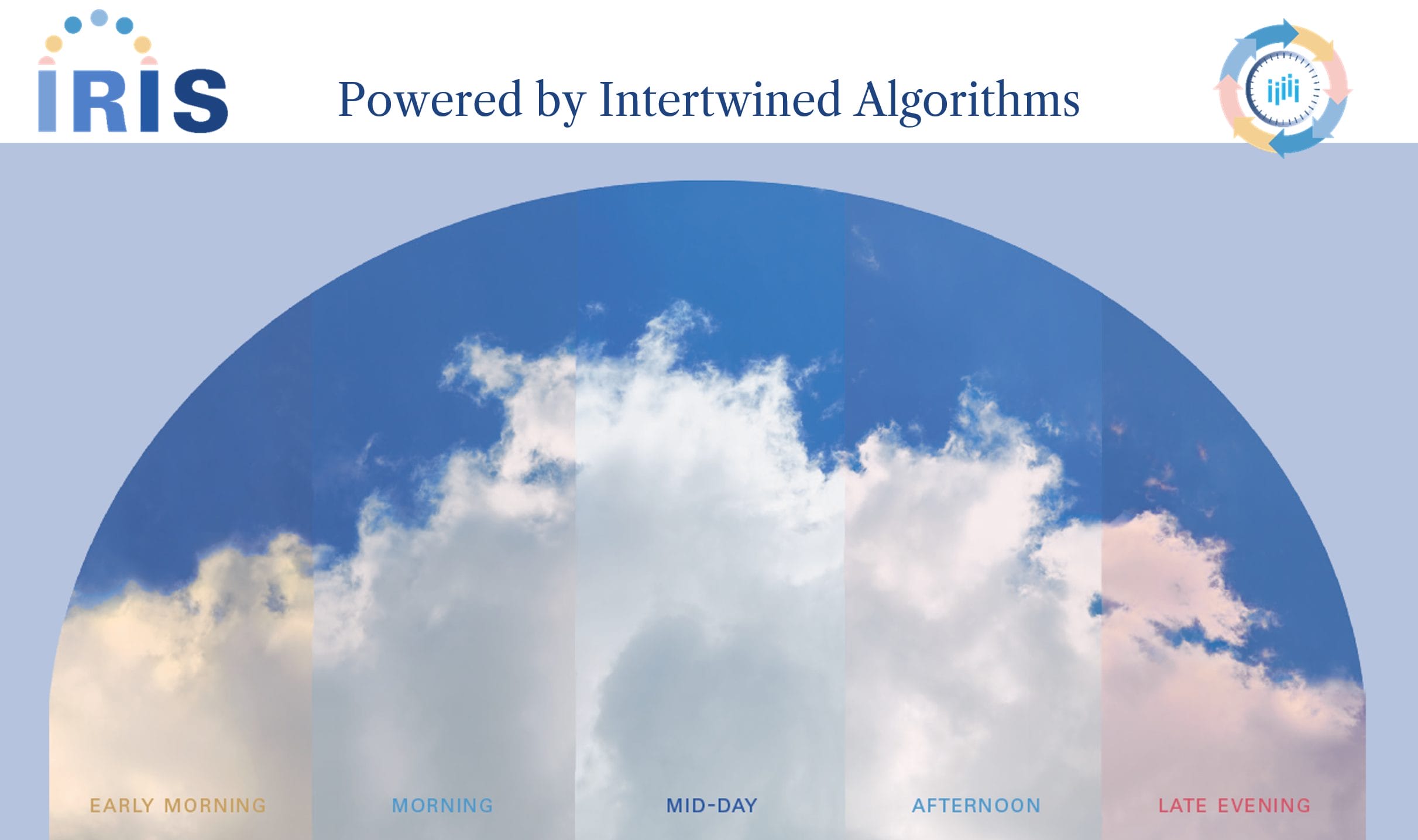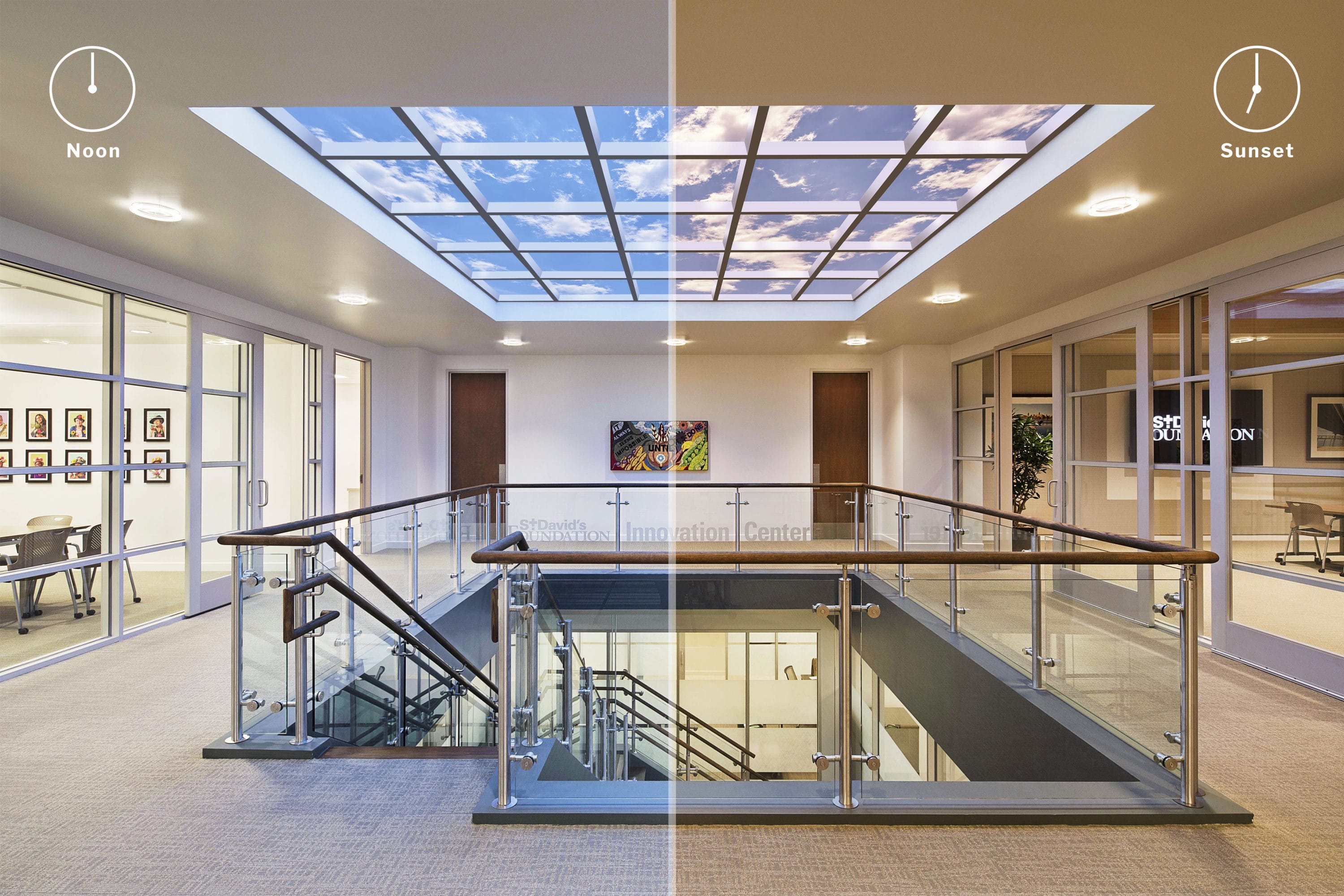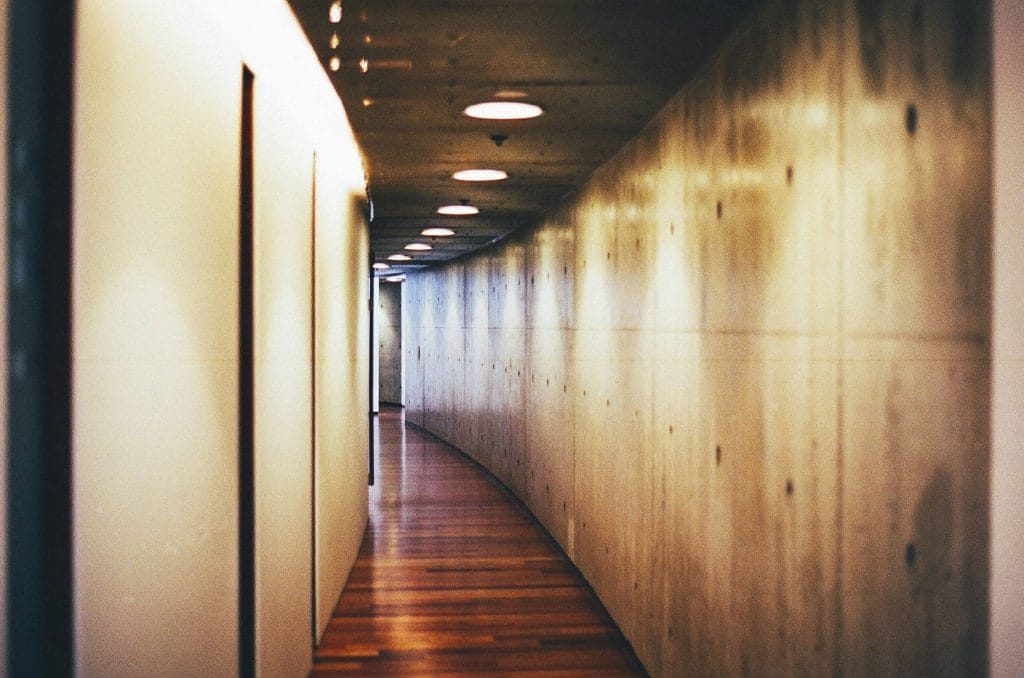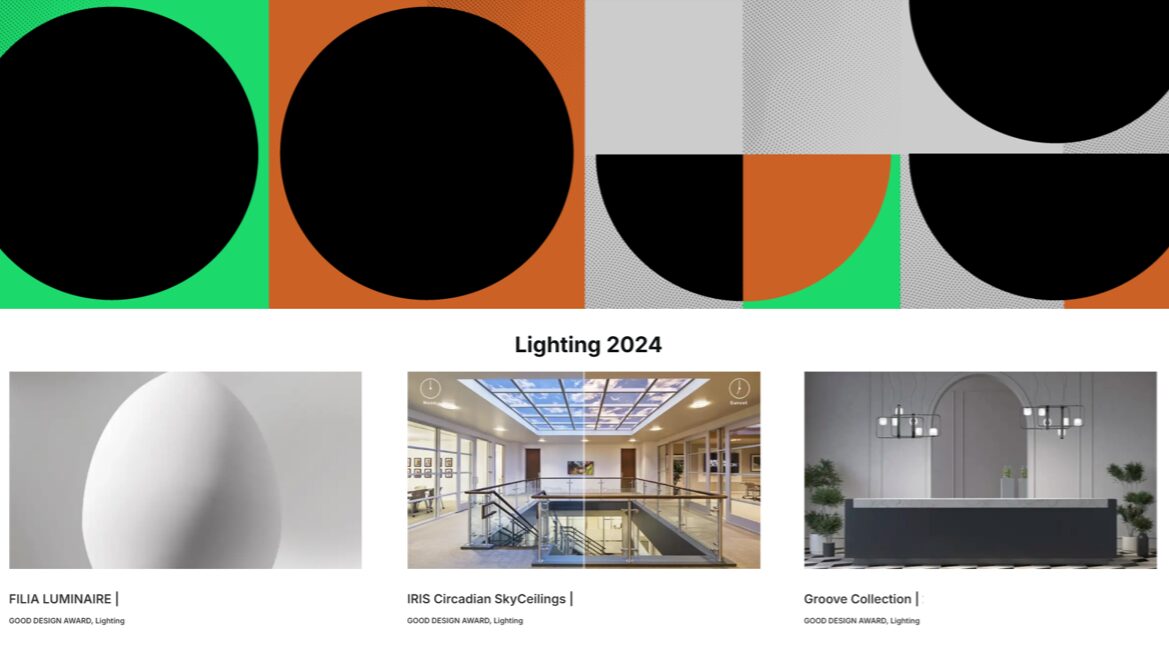Part II of this series established that visual illusions represent a powerful sensory vehicle to generate a perceived connection to a natural exterior from within enclosed interiors. In Part III, we explore the attributes of bone fide sky illusions and their contributing role within a dynamic sky illusion.

For starters, biophilic illusions of nature create realistic scenes by featuring cloud layers and foliage in a gravitationally-correct orientation. Clouds and tree branches embody natural patterns and compositional elements that our senses recognize as bone fide spatial cues, engaging our brain’s embedded memory maps of three-dimensional space.

On the other hand, monochromatic virtual portals of the sky lack these sensory-rich contextual cues that help our brain ascertain scale, depth, and spatial polarity. After all, we know from experience that when gazing directly overhead, at a cloudless blue sky, it’s easy to lose all sense of distance once landmarks disappear from our peripheral vision.
Tilting our heads back for a minute or two, the sky before our eyes could be 10,000 or 100,000 feet overhead; the cool vastness of midday blue offers only the colossal scale before us––no limitations or boundaries. Outdoors, other sensory cues like the rustling of leaves or the fresh odor of sea breeze help establish the scale of our surroundings. But indoors, the lack of other sensory cues tends to flatten any monochromatic view to perceived open space.

It is also interesting to note that biophilic illusions of nature, despite relying on static photography, generate a dynamic bi-sensory effect. Non-moving Open Sky Compositions, the imagery used in Luminous SkyCeilings, have accumulated a consistent record of occupant testimonials noting a curious cognitive phenomenon. Up to one third of observers looking up at an illusory Open Sky Composition in the supine position report a visual perception of cloud motion when viewing a SkyCeiling.
It is likely this illusory visual artifact is born of eye movements imposed on the captive observer by the composition. Once our attention is drawn to a salient feature in a smaller quadrant, say one depicting a beautiful blossom or leaf, the rest of the scene falls just outside our fovea’s high visual acuity range, and our hardwired habits of perception take over.
Every time we focus on the foreground elements (objects) of an outdoor scene, our innate habits of perception––based on our past memories of cloud movement, expect clouds to drift in the background (scene). So when we look at a nearby object like a leafy branch overhead, even though it is only a photorealistic depiction, the context is so similar to the one we’ve experienced in the past, that our brain cannot help but anticipate their movement! That’s how powerful our memory of visual stimuli can be: it literally takes over what we see.
This is also why biophilic illusions are bi-sensory. Their effect is both visual and spatial. We literally experience two-dimensional illusions in a perceived three-dimensional space.

This cognitive mechanism, where memory colors what we perceive, can also be leveraged when we combine a circadian pattern with the tunable oscillations of the lighting source behind a sky image. Whereas monochromatic virtual skylights without image content have a simple task––that of modulating the light emitted from a uniform background––the proper modulation of a compositional scene featuring clouds (and/or foliage) and blue sky becomes a more sophisticated project as the color wavelength transformations need to resonate with our accumulated sensory experience.
Early tunable lighting systems attempted to filter different wavelengths through a static photograph, but witnessed discordant color shifts as a uniform shift in tonality––say from warm to cool––would distort the careful color balance achieved by a neutral white light source.
It appeared that modulating a visual scene replete with subtle hues and rich in color saturation might not be feasible with a single tunable light source.
Sky Factory artists worked with lighting engineers to solve this vexing puzzle. The emerging LED lighting system powering I R I S, the company’s second generation Circadian SkyCeiling, found the solution with a system that relies on two complementary algorithms––PRiSM and DiAL. PRiSM (Proprietary index of Spectrum Modulations), the first algorithm component, employs an array of seven color wavelengths whose calibrated ratios are dynamic, thereby generating a rich tonal range across the image panels.
Furthermore, PRiSM delivers diurnal changes in both intensity and tonal hue that faithfully mimic the most dramatic peaks seen at sunrise and sunset. Stimulating our retinal cones, which are a thousand times more sensitive to warm color temperatures than the intrinsically photosensitive Retinal Ganglion Cells (ipRGC) that were once thought to be the sole solution to circadian entrainment, PRiSM’s programmable sunrise-to-sunset arc takes advantage of our cones’ direct neural wiring to our body’s master circadian clock.


PRiSM’s LED starboards are also custom positioned as per the visual content of the accompanying panel to synchronize with the compositional elements in each Open Sky Composition. The algorithm’s seven color wavelengths alter their luminous ratios according to the visual topography of the illusory sky, generating a vivid display of dynamic light that also minimizes the tonal variability of certain compositional elements that require more stable color consistency.
This ability to distribute subtle hues and rich saturation within the image itself makes I R I S a singular achievement in dynamic lighting. The PRiSM function works within an integrated software package that tethers all I R I S installations to their final geographic location, anywhere in the world, as well as to the appropriate seasonal length-of-day.
However, this is just the beginning of the product’s technical feats. Aside from orchestrating a masterful metamorphosis of color gradients over a perceived volume, I R I S also manages to mimic another complex natural phenomenon: daylight variability.
A Diurnal Play of Light: The DiAL Algorithm
Up until the early 20th Century when electric lighting took over commercial architecture and jobs migrated to large interiors, our physiology was exposed to the dynamic illumination inherent in daylight.
One of the least appreciated biophilic phenomena of daylight is the daily atmospheric process of cloud formation. As the sun rises over the eastern horizon and begins to warm the earth and air, it starts a massive process of moisture evaporation over the landscape that results in the formation of clouds.
As it reaches higher altitudes, the accumulating water moisture condensates and begins to coalesce into large vaporous bodies that begin to dominate the sky. And as these massive clouds drift, they diffuse and, to varying degrees, block the sunlight reaching the landscape below, generating irradiance fluctuations as the sun disappears, peeks around the edges, or pierces through the gaps in their shape-shifting, diaphanous bodies.

While many of us have experienced the joy of following cloud shadows on land, taking in their colossal scale and actual speed over landmarks and vast terrain, few of us have really thought what their effect might be on our ability to think.
It turns out that this innocent therapeutic exposure to the momentary variations in the pattern of one’s local daylight is a biophilic response that helps to invigorate and restore attention.
Outside, under the sky, it is easy and natural to refresh one’s attention through innocent awareness of nature’s many sensory events; gusts of wind rustling a multitude of leaves, a flock of birds suddenly bursting into flight or, the gentle up swell of a warm breeze on your body as it shifts direction.
Indoors, inside our hermetically sealed commercial buildings, access to this type of fortuitous sensory stimulus is highly unlikely. And if we also happen to work in an area far from windows or where windows face an urban landscape or lay in the shadow of larger buildings, then our ability to recharge our attention is further diminished. In sum, our migration indoors has pulled us apart from one of the most underrated restorative effects of daylight: its natural, dynamic variability.
For this reason, I R I S, our new Circadian SkyCeiling, has incorporated this vital feature into the sky illusion under a complementary algorithm we call DiAL (Daylight intensity Algorithm). The DiAL function modulates the kind of daylight intensity changes that signal spatial transitions brought about by the natural buildup of clouds, their accumulation and passage over the landscape and eventual dissipation in the evening.
While the clouds in an I R I S SkyCeiling do not actually move, the illusion of movement is born out of our hardwired habits of perception. Not only does our brain trick us into perceiving movement in the clouds due to the illumination and compositional elements that make up the image, but the light intensity fluctuations from the DiAL algorithm further enhance the illusion by mimicking the timing and intensity changes that occur beneath a real skylight with real clouds drifting overhead.
DiAL’s subtle, oscillatory changes in light intensity embody cues, registered primarily by our peripheral vision. Peripheral vision represents 95% of our visual field. These dynamic inputs to peripheral vision deepen biophilic engagement and foster mental alertness during the long day, indoors. The DiAL function enables occupants to detect small changes in light fluctuations that help mitigate the adverse effects of sensory adaptation.

Sensory adaptation is defined as a decrease in sensitivity to an unchanging stimulus and it is a prevalent phenomenon in large commercial interiors where artificial lighting is used extensively. Such habituation results in reduced sensitivity, mental fatigue and for many occupants, leads to eye strain, headaches, and poor performance, common drawbacks of static or isolated environments. However, changes in illumination don’t need to be drastic or dramatic, just enough to reach the difference threshold for sensory adaptation. The difference threshold, first described by 19th Century physiologist and experimental psychologist Ernst Weber, is defined as the smallest difference in stimulation that can be detected 50 percent of the time, also known as Weber’s Law of Just Noticeable Differences.
Further, the natural fluctuations of daylight due to the passage of cloud patterns overhead are registered in such a subtle manner that they help enliven attention or spur a moment of relaxation as one shifts from focused work back to awareness of one’s surroundings. It is interesting to note that landmark experiments dating back to the 1940s established that dark-adapted human subjects were capable of reporting light signals as low as a few photons. Therefore, the therapeutic power of one’s attunement to environmental changes such as subtle variations in daylight lies in their recurrent reappearances throughout the day more than their intensity.
I R I S – A Luminous SkyCeiling
Stay tuned for the upcoming release of our 2nd generation, tunable illusion of nature and learn more about its architectural context, the SkyCeiling products that it’s compatible with, and the recommended Open Sky Compositions suitable for I R I S.
If you’d like to inquire today, please contact our Sky Designer team.



